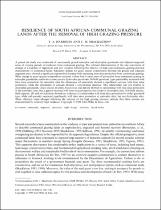 ResearchSpace
ResearchSpace
Resilience of South African communal grazing lands after the removal of high grazing pressure
JavaScript is disabled for your browser. Some features of this site may not work without it.
- ResearchSpace
- →
- Research Publications/Outputs
- →
- Journal Articles
- →
- View Item
| dc.contributor.author |
Harrison, YA

|
en_US |
| dc.contributor.author |
Shackleton, CM

|
en_US |
| dc.date.accessioned | 2007-03-28T08:53:47Z | en_US |
| dc.date.accessioned | 2007-06-07T10:07:27Z | |
| dc.date.available | 2007-03-28T08:53:47Z | en_US |
| dc.date.available | 2007-06-07T10:07:27Z | |
| dc.date.copyright | en_US | |
| dc.date.issued | 1999-05 | en_US |
| dc.identifier.citation | Harrison, YA and Shackleton, CM. 1999. Resilience of South African communal grazing lands after the removal of high grazing pressure. Land Degradation & Development, vol. 10(3), pp 225-239 | en_US |
| dc.identifier.issn | 1085-3278 | en_US |
| dc.identifier.uri | http://hdl.handle.net/10204/2157 | en_US |
| dc.identifier.uri | http://hdl.handle.net/10204/2157 | |
| dc.description.abstract | A paired site study was conducted of communally grazed eutrophic and dystrophic grasslands and adjacent ungrazed areas of varying periods of exclusion from communal grazing. This allowed determination of the rate and extent of change of a number of vegetation and soil variables following the removal of high and continuous grazing pressure characteristic of communal lands. Similarity indices for grass species composition between the grazed and adjacent ungrazed areas showed a significant exponential decrease with increasing time since protection from continuous grazing. Most change in grass species composition occurred within four to nine years of protection from communal grazing in eutrophic grasslands, and in six to nine years in dystrophic grasslands. In both grassland types palatability increased with time since protection. In eutrophic sites the abundance of perennials showed a significant increase with time since protection, while the abundance of annuals showed a concomitant decrease. This relationship was not evident in dystrophic grasslands. Grass species diversity, basal cover and density showed no relationship with time since protection in the eutrophic sites, but a general increase with time since protection was found in dystrophic sites. Soil bulk density, field capacity, pH and soil nutrients showed no evidence of a relationship with time since protection for either grassland type, while soil porosity increased significantly with time since protection at eutrophic sites, but not dystrophic sites. These relatively rapid changes following the removal of the high grazing pressure indicate that these systems are characterized by relatively high resilience. | en_US |
| dc.format.extent | 182162 bytes | en_US |
| dc.format.mimetype | application/pdf | en_US |
| dc.language.iso | en | en_US |
| dc.publisher | John Wiley & Sons Ltd | en_US |
| dc.rights | Copyright:1999 John Wiley & Sons, Ltd. | en_US |
| dc.source | en_US | |
| dc.subject | Communal grazing lands | en_US |
| dc.subject | Degraded lands | en_US |
| dc.subject | Rapid changes | en_US |
| dc.subject | Resilience | en_US |
| dc.subject | South Africa | en_US |
| dc.subject | Enviromental sciences | en_US |
| dc.title | Resilience of South African communal grazing lands after the removal of high grazing pressure | en_US |
| dc.type | Article | en_US |
| dc.identifier.apacitation | Harrison, Y., & Shackleton, C. (1999). Resilience of South African communal grazing lands after the removal of high grazing pressure. http://hdl.handle.net/10204/2157 | en_ZA |
| dc.identifier.chicagocitation | Harrison, YA, and CM Shackleton "Resilience of South African communal grazing lands after the removal of high grazing pressure." (1999) http://hdl.handle.net/10204/2157 | en_ZA |
| dc.identifier.vancouvercitation | Harrison Y, Shackleton C. Resilience of South African communal grazing lands after the removal of high grazing pressure. 1999; http://hdl.handle.net/10204/2157. | en_ZA |
| dc.identifier.ris | TY - Article AU - Harrison, YA AU - Shackleton, CM AB - A paired site study was conducted of communally grazed eutrophic and dystrophic grasslands and adjacent ungrazed areas of varying periods of exclusion from communal grazing. This allowed determination of the rate and extent of change of a number of vegetation and soil variables following the removal of high and continuous grazing pressure characteristic of communal lands. Similarity indices for grass species composition between the grazed and adjacent ungrazed areas showed a significant exponential decrease with increasing time since protection from continuous grazing. Most change in grass species composition occurred within four to nine years of protection from communal grazing in eutrophic grasslands, and in six to nine years in dystrophic grasslands. In both grassland types palatability increased with time since protection. In eutrophic sites the abundance of perennials showed a significant increase with time since protection, while the abundance of annuals showed a concomitant decrease. This relationship was not evident in dystrophic grasslands. Grass species diversity, basal cover and density showed no relationship with time since protection in the eutrophic sites, but a general increase with time since protection was found in dystrophic sites. Soil bulk density, field capacity, pH and soil nutrients showed no evidence of a relationship with time since protection for either grassland type, while soil porosity increased significantly with time since protection at eutrophic sites, but not dystrophic sites. These relatively rapid changes following the removal of the high grazing pressure indicate that these systems are characterized by relatively high resilience. DA - 1999-05 DB - ResearchSpace DP - CSIR KW - Communal grazing lands KW - Degraded lands KW - Rapid changes KW - Resilience KW - South Africa KW - Enviromental sciences LK - https://researchspace.csir.co.za PY - 1999 SM - 1085-3278 T1 - Resilience of South African communal grazing lands after the removal of high grazing pressure TI - Resilience of South African communal grazing lands after the removal of high grazing pressure UR - http://hdl.handle.net/10204/2157 ER - | en_ZA |





